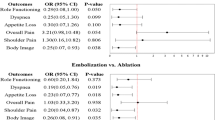Abstract
Accurate assessment of utilities to calculate quality-adjusted life expectancy for medical interventions is needed in cirrhosis. To date, limited data exist in cirrhotics and are generally physician-assigned. Therefore, our aim was to determine utilities for six clinical scenarios in cirrhosis and to define if differences exist in utilities assigned by physicians versus patients. We administered a questionnaire to 83 physicians and 114 cirrhotics to obtain utilities using the time trade-off method for (1) compensated cirrhosis, (2) decompensated cirrhosis, (3) encephalopathy, (4) spontaneous bacterial peritonitis, (5) variceal bleeding, and (5) hepatocellular carcinoma. On a scale from 0 (death) to 1 (perfect health), mean utilities of physicians and patients were compared using the Student t test. One-way analysis of variance was used to compare the utilities between patients according to Child–Pugh class. Statistical significance was defined as a P value <0.05. The mean age of the physicians was 42±11, with 52% being male. The mean age of the patients was 52±9; with 59% male. The mean Child–Pugh score was 8±2 and HCV was the most common etiology (54%). The mean utilities for physicians and patients were as follows: CC, 0.78 vs. 0.88; DC, 0.55 vs. 0.74; E, 0.38 vs. 0.55; SBP, 0.33 vs. 0.45; VB, 0.27 vs. 0.40; and HCC, 0.19 vs. 0.30. All comparisons were statistically significant. Although physicians and patients assigned similar relative rankings to each health state, physicians assigned utilities were significantly different from those assigned by patients. These results suggest that studies that have used physician-assigned utilities do not accurately reflect patient preferences.
Similar content being viewed by others
References
World Health Organization: World Health Organization Constitution. In Basic Documents. Geneva, World Health Organization, 1948
Borgaonkar MR, Irvine EJ: Quality of life measurement in gastrointestinal and liver disorders. Gut 47:444-454, 2000
Brown RS Jr: Strategies and pitfalls in quality of life research. Hepatology 29:9S-12S, 1999
McGrew DM: Chronic illnesses and the end of life. Primary Care Clin Office Pract 28:339-347, 2001
Roth K, Lynn J, Zhong Z, et al.: Dying with end stage liver disease with cirrhosis: insights from SUPPORT. J Am Geriatr Soc 8:S122-S130, 2000
Schomerus H, Hamster W: Quality of life in cirrhotics with minimal hepatic encephalopathy. Met Brain Dis 16:37-41, 2001
Younossi ZM: Chronic liver disease and health-related quality of life. Am J Gastroenterol 120:305-307, 2001
Testa M, Simonson D: Assessment of quality of life outcomes. N Engl J Med 334:835-840, 1996
Wilson I, Cleary P: Linking clinical variables with health-related quality of life. JAMA 273:59-65, 1995
Bayliss MR: Methods in outcomes research in hepatology: Definitions and domains of quality of life. Hepatology 29:3S-6S, 1999
Younossi ZM, Guyatt G: Quality-of-life assessments and chronic liver disease. Am J Gastroenterol 93:1037-1041, 1998
Younossi ZM, et al.: Development of a disease specific questionnaire to measure health related quality of life in patients with chronic liver disease. Gut 45:295-300, 1999
Gralnek IM, Hays RD, Kilbourne A, et al.: Development and evaluation of the Liver Disease Quality of Life Instrument in persons with advanced, chronic liver disease—The LDQOL 1.0. Am J Gastroenterol 95:3552-3565, 2000
Unal G, de Boer JB, Borsboom GJ, et al.: A psychometric comparison of health-related quality of life measures in chronic liver disease. J Clin Epidemiol 54:587-596, 2001
Yacavone RF, Locke GR, Provenzale DT, et al.: Quality of life measurement in gastroenterology: What is available? Am J Gastroenterol 96:285-297, 2001
Kaplan RM: Utility assessments for estimating quality-adjusted life-years. In Valuing Health Care, 1st ed. Sloan F (ed). New York, Cambridge University Press, 1995, pp 31-60
Younossi ZM, Boparai N, McCormick M, et al.: Assessment of utilities and health-related quality of life in patients with chronic liver disease. Am J Gastroenterol 96:579-583, 2001
Owens DK, Cardinalli AB, Nease RF Jr: Physicians' assessments of the utility of health states associated with the human immunodeficiency virus (HIV) and hepatitis B virus (HBV) infection. Qual Life Res 6:77-86, 1997
Younossi ZM, Boparai N, Price LL, et al.: Health-related quality of life in chronic liver disease: the impact of type and severity of disease. Am J Gastroenterol 96:2199-2205, 2001
Hussain KB, Fontana RJ, Moyer CA, et al.: Comorbid illness is an important determinant of health-related quality of life in patients with chronic hepatitis C. Am J Gastroenterol 96:2737-2744, 2001
Forton DM, Taylor-Robinson SD, Thomas HC: Reduced quality of life in hepatitis C—Is it all in the head? J Hepatol 36:435-438, 2002
Fontana RJ, Moyer CA, Sonnad S, et al.: Comorbidities and quality of life in patients with interferon-refractory chronic hepatitis C. Am J Gastroenterol 96:170-178, 2001
Panel on Cost-effectiveness in Health and Medicine: Summary recommendations. In Cost-Effectiveness in Health and Medicine. Gold MR, Siegel JE, Russell LB, and Weinstein MC (eds). New York, Oxford Univeristy Press, 1996, pp 304-311
Kim WR, Poterucha JJ, Hermans JE, et al.: Cost-effectiveness of 6 and 12 months of interferon-α therapy for chronic hepatitis C. Ann Intern Med 127:866-874, 1997
Bennett WG, Inoue Y, Beck JR, et al.: Estimates of the cost-effectiveness of a single course of interferon-α2b in patients with histologically mild chronic hepatitis C. Ann Intern Med 127:855-865, 1997
Tsevat J, Solzan JG, Kuntz S, et al.: Health values of patients infected with the human immunodeficiency virus. Med Care 34:44-57, 1996
Author information
Authors and Affiliations
Rights and permissions
About this article
Cite this article
Wells, C.D., Murrill, W.B. & Arguedas, M.R. Comparison of Health-Related Quality of Life Preferences Between Physicians and Cirrhotic Patients: Implications for Cost–Utility Analyses in Chronic Liver Disease. Dig Dis Sci 49, 453–458 (2004). https://doi.org/10.1023/B:DDAS.0000020502.46886.c1
Issue Date:
DOI: https://doi.org/10.1023/B:DDAS.0000020502.46886.c1



